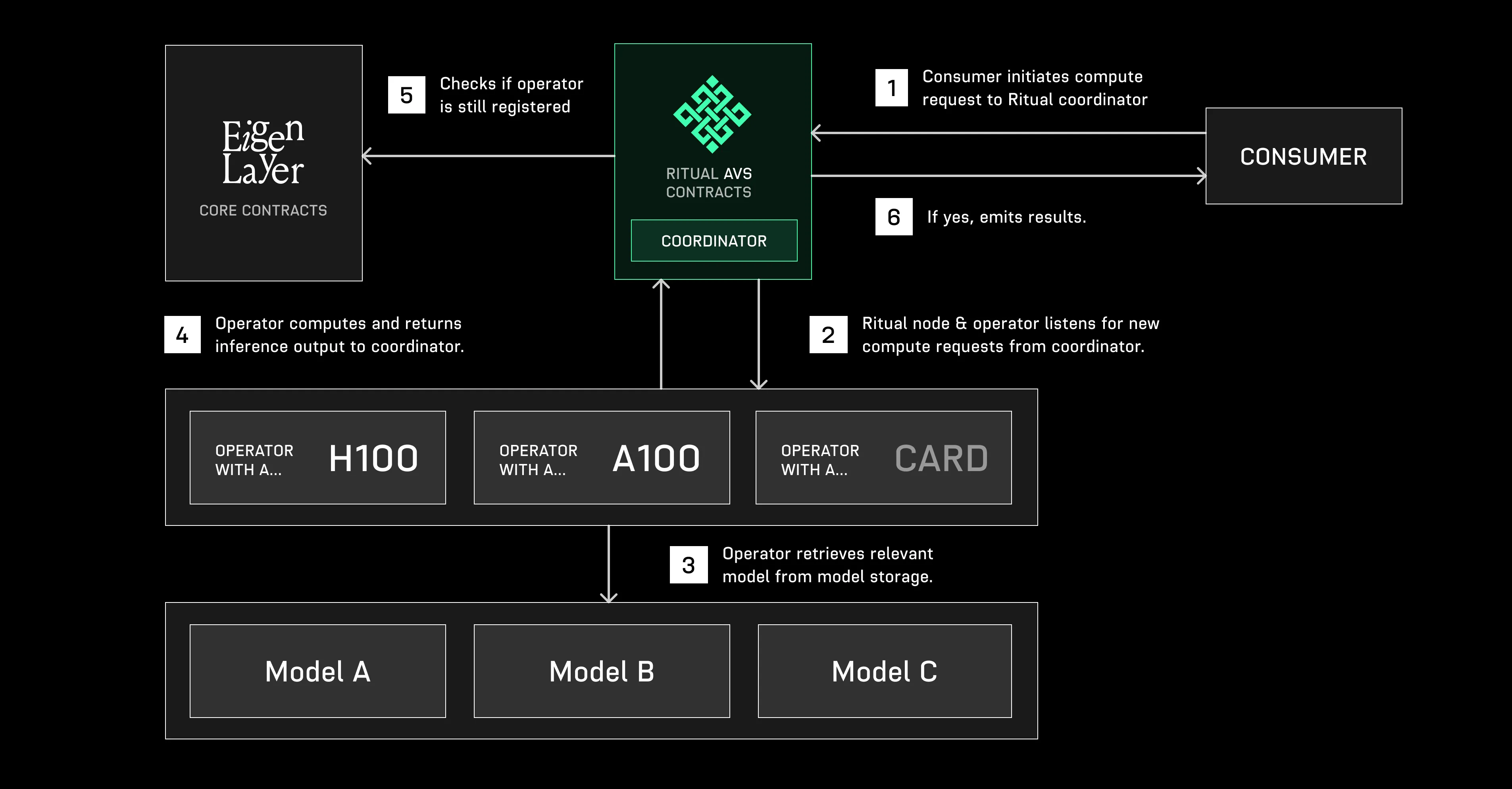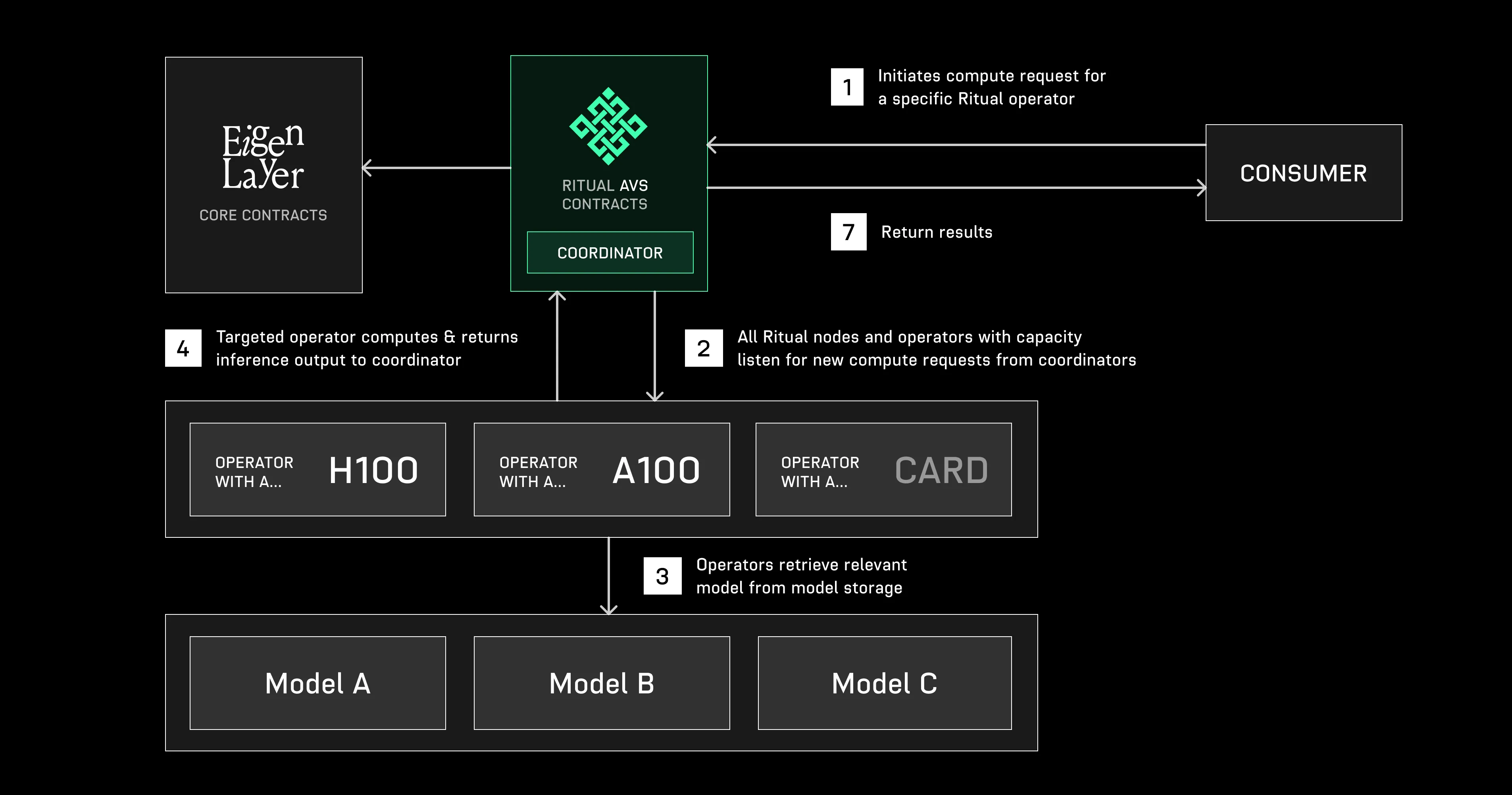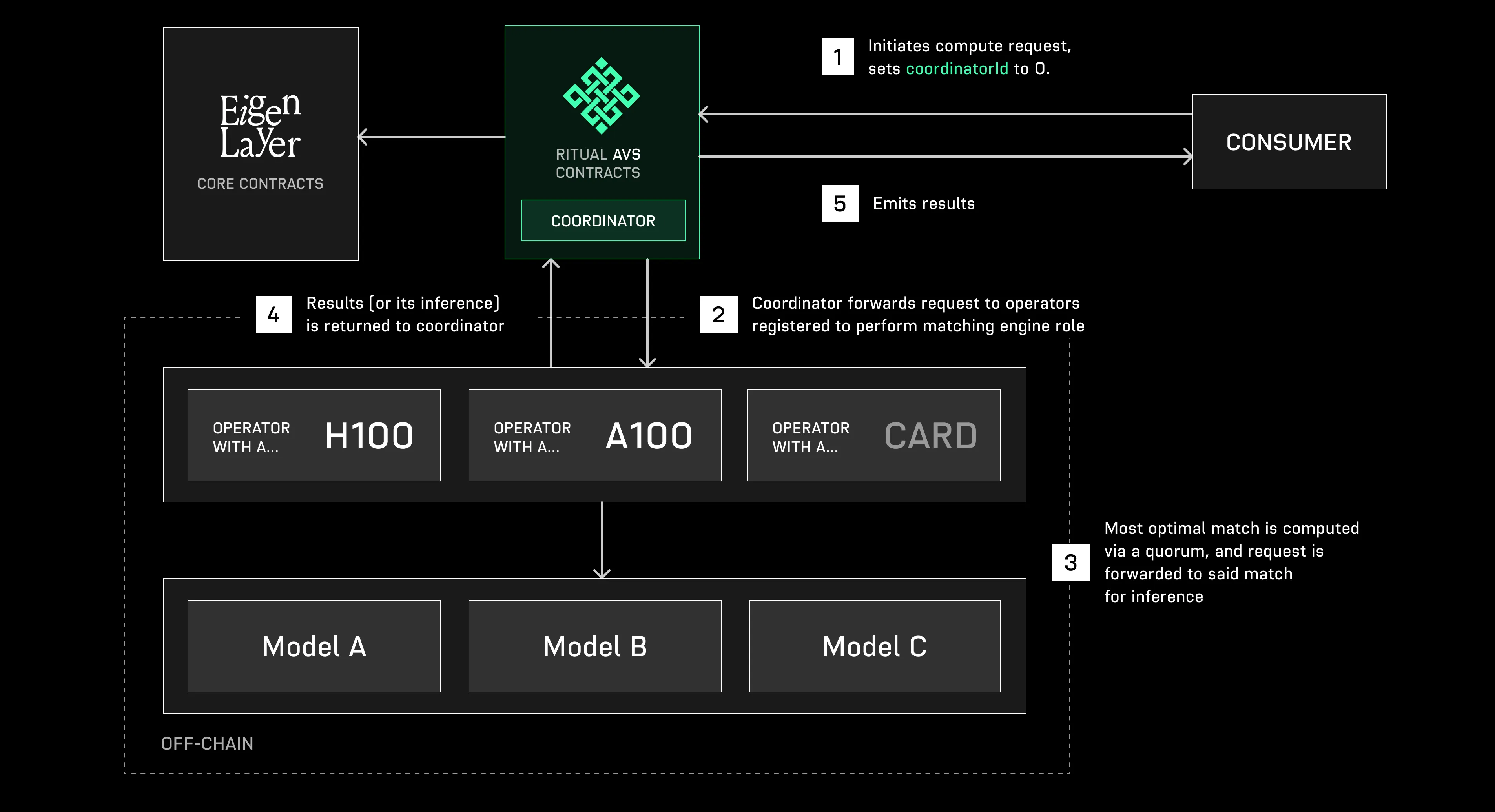Today, Ritual and EigenLayer are excited to announce an ongoing partnership that will develop new Actively Validated Services (AVSs) to power various parts of Ritual’s Infernet and chain, while also unlocking new, unique AI-native opportunities for operators on EigenLayer.
Ritual’s Vision
Ritual is building the world’s first sovereign, community-owned AI network. The initial phase of Ritual is Infernet, the first product of its kind to allow smart contracts to natively access AI models for a variety of on-chain use cases and tasks via a decentralized oracle network (DON). Over the next few months, we will be rolling out the second phase of Ritual: a sovereign chain built with a custom VM optimized for AI-native operations across models. You can read more on our product page.
Several parts of Ritual’s feature set require strict economic and security guarantees . EigenLayer’s restaking mechanism enables Ethereum stakers to provide other applications with strong economic security inherited from Ethereum in return for diversified revenue streams. By combining the two, Ritual can take advantage of the properties inherited via EigenLayer to build new actively validated services (AVSs) for various AI-related workstreams while fulfilling its economic and security guarantees. EigenLayer enables Ritual to provide a strong level of decentralization and security for AI operations over the network from genesis, while also providing EigenLayer operators access to an entirely new form of yield.
Ritual AVSs
As Ritual prepares to release its sovereign chain, it’s important that the network enjoys a strong level of security from day one. Thanks to EigenLayer’s restaking mechanism, node operators on EigenLayer can opt in to dual stake on the networks (with minimal overhead), securing a variety of services on the Ritual chain in return for relevant incentives. Thanks to EigenLayer’s nearly $8bn in TVL and diverse node set, this will enable Ritual chain and many of its features to enjoy a high level of economic security and decentralization at inception, which is core to both our protocol design and ethos. Users of EigenLayer will similarly enjoy access to Ritual and its ecosystem as soon as it’s live.
There are several AVSs that will be built as a result of this. Below, we outline a few.
Model Operations via EigenLayer Operators

Ritual provides the coordination for users to initiate and receive the results of model operations (inference, finetuning, quantization, distillation, training, etc.) off and on-chain through a network of nodes capable of serving models. EigenLayer operators with access to compute can restake and register as Ritual nodes to provide users access to these operations. As Ritual integrates payment streams for these services, restakers will benefit from the revenue generated from doing so. These operations are enshrined in the Ritual VM, making it as easy for these operators to participate in these services as running the Ritual client and participating in dual staking.
Proof Marketplace

An important property that Ritual enables is the inclusion of proofs that provide guarantees around the computational integrity of model operations. In the inference scenario, for example, it’s critical in certain cases that the end user (which could be a smart contract!) is able to trustlessly verify that the output of a model from their query was not tampered with in any form by the node running it. To this end, there needs to be both a way to attach these proofs to model outputs and a way to disincentivize nodes from submitting faulty outputs.This same assumption can scale for a variety of operations (i.e. being able to prove that someone was the true originator of a model during training). Building to accommodate for these proofs is important in bridging some of the trust assumptions that may arise across a variety of AI workflows and use cases.
Ritual already includes the ability to include optional proofs for outputs returned to the system. Once EigenLayer slashing is live, operators on EigenLayer registered as nodes on Ritual can begin providing proofs for generated model operations, with their posted bond being slashed if they are found to generate a faulty inference. This means that the proof constructions above on Ritual will be able to inherit the economic security from EigenLayer, while forwarding the payments for these proving services to restaked nodes.
Furthermore, as Ritual continues to work both internally and with external collaborators on extending different proofs around the entire model operation stack, we imagine that there will exist a Proof Marketplace over the Ritual chain. It may not always be the case that users desire proofs around certain properties (i.e. the need to computationally verify a model generating pics of an anime waifu is *likely* less than the need for verifying a model used by a DeFi protocol with significantly TVL), but if they do it’s important they are able to express that desire via additional incentives and for end node operators providing those proofs to receive those in kind. We imagine that restakers on EigenLayer will contribute to the set of nodes that are able to provide these proofs, and will help bootstrap the supply-side of this marketplace.
Model Routing

As users gain access to an increasing number of models and nodes with various functionality, being able to be routed to the best model and the best provider given user preferences will become a key functionality. Factors such as node geography (for latency), the compute hardware they have access to, and which model is best suited for their task (based on, for example, evaluation metrics) are important to match users to what they actually need.
This presents the opportunity for addition of routers on Ritual to help users find the best nodes and models for them. Restaked EigenLayer nodes can act as routers, creating a matching engine over Ritual to best serve users. The design space for how to optimally match users to nodes and models is an expansive one, and EigenLayer will help bring a diversity of operators and routing strategies to Ritual.
New Frontiers
The designs detailed above are just the tip of an iceberg. As part of the ongoing partnership between the two protocols, we look forward to unveiling new ways of harnessing Ethereum’s native security and capital to secure AI-related services. The design space here is infinite- we’d also love to hear from and work with the community on ideas they have for other ways staking can be used to develop services over Ritual and EigenLayer!
For more updates on this front, follow Ritual and EigenLayer on Twitter. To learn how to run a Ritual node, check out our documentation here.
Disclaimer: This post is for general information purposes only. It does not constitute investment advice or a recommendation, offer or solicitation to buy or sell any investment and should not be used in the evaluation of the merits of making any investment decision. It should not be relied upon for accounting, legal or tax advice or investment recommendations. The information in this post should not be construed as a promise or guarantee in connection with the release or development of any future products, services or digital assets. This post reflects the current opinions of the authors and is not made on behalf of Ritual or its affiliates and does not necessarily reflect the opinions of Ritual, its affiliates or individuals associated with Ritual. All information in this post is provided without any representation or warranty of any kind. The opinions reflected herein are subject to change without being updated.